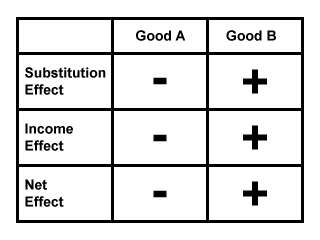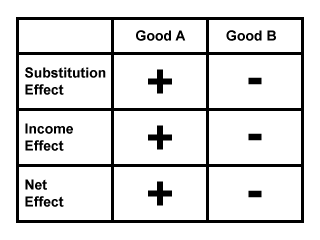Normal, Inferior, and Giffen Goods
Are all goods the same? Is more always better? Up to this point, we have been assuming that when we have more money, or feel like we have more money, we will tend to buy more goods. It makes sense: the more money we have, the more we buy. If we have less money, or if the price goes up, however, we tend to buy less. Because this is usually the case, we call such goods normal goods. If you buy more of a good when you have more money, that good is a normal good. If the price of a normal good increases, you buy less.
There are some exceptions, however: not all goods are normal goods. For instance, if an increase in your income causes you to buy less of a good, that good is called an inferior good. For instance, "poor college students" often satisfy themselves with generic soda and cheap ramen. When they get jobs and a steady income, however, they might forego the cheap soda and ramen in favor of Coke and pasta. In this example, the generic soda and cheap ramen are inferior goods.
Income and substitution effects change demand differently with different types of goods. For instance, we have been looking at income and substitution effects when a buyer is faced with a choice between two normal goods. An increase in the price of good A will cause a decrease in consumption of A, and an increase in consumption of good B (assuming that the substitution effect is stronger than the income effect). If good A is a normal good, and good B is inferior, however, the results will be different.
Why is this true? Consider the case where the price of good A goes up.

Income and Substitution Effects with Normal and Inferior Goods
If the A is still normal and B is still inferior, and the price of A falls, then the substitution effect will cause higher consumption of A and lower consumption of B, and the income effect will cause higher consumption of A and lower consumption of B. Because the buyer now feels richer, they are less inclined to buy the inferior good.

Income and Substitution Effects with Normal and Inferior Goods
Another exception is the case where an increase in price causes an increase in demand. This results in an upward-sloping demand curve, and the good is called a Giffen good. Giffen goods are theoretically possible, but very improbable, since it is unlikely that an increase in price causes increase in demand. One possible justification for a Giffen good is that people associate higher prices with status, luxury, and quality, so that a higher price might increase the perceived value of a good. In reality, however, this effect is outweighed by the overwhelming tendency to prefer lower prices: even if a few people prefer the added cachet of a high-priced luxury good, the general public will prefer lower prices. Another possible case that could cause a Giffen good is the case in which a good is inferior and the income effect outweighs the substitution effect. To illustrate, assume that ACME Cola is an inferior good. When it's price increases, the income effect makes Calvin feel poorer. If the income effect is very strong, and the substitution effect is very weak, then Calvin will buy more ACME Cola, because the consumption of inferior goods increases with decreases in income. This, too, is unlikely, however, because the substitution effect is almost always stronger than the income effect.













